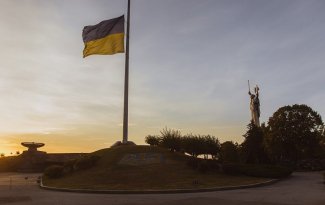The Russians are making slow progress. Day 649 of the war

In early December, Russian forces pushed the defenders out of the south-western part of Marinka. Most of the town, which has been completely destroyed in the fighting, is now under the control of the invaders. The Ukrainians are only holding out on the north-western outskirts, and the area they control is estimated at 10% of the total. The invaders are also continuing their attacks in the other directions, and in some of them their troops have moved distances ranging from a few hundred metres to one kilometre. In recent days, they have recorded further advances north-west of Kreminna, advancing towards the villages of Terny and Yampolivka, as well as west of Bakhmut, pushing defenders out of that town’s south-western suburbs towards the village of Ivanivske. North of Avdiivka, Russian forces have expanded the area they control west of the railway line, and they now outflank the village of Stepove. On 1 December, they also crossed part of the Ukrainian line of fortifications west of Avdiivka, outflanking the village of Sieverne and approaching one of the fortified areas in the town from the west, in the area of the so-called ninth quarter (the Khemik micro-district).
To the north-east of Kupyansk, the region of Synkivka has seen head-to-head clashes, but the defenders did not allow the Russians to consolidate their holdings in its northern part. Subsequent Russian attempts to push the Ukrainians out of the central part of Krynky on the left bank of the Dnieper were also unsuccessful. The defenders are still intending to throw reinforcements across the river and make an effective counterattack. The observed shift of some Ukrainian forces operating south of Orikhiv in Zaporizhzhia oblast to other directions on 4 December signals that the invaders may try to launch an assault in the Robotyne-Verbove area, but so far they have not made significant progress. According to a report from the Ukrainian General Staff, despite the difficult weather conditions, the enemy has not significantly reduced the frequency of its assaults; in the main directions the number is still running at around 20 per day.
On the night of 5 December, Russian kamikaze drones struck an infrastructure facility in Lviv oblast, and also attacked the airfield in Starokostiantyniv in Khmelnytskyi oblast, which had also been targeted by Shaheds on the two previous nights. In addition, on 4 December they struck Borova and Chuhuyev in Kharkiv oblast, as they did on 2 December in Odessa oblast, damaging local infrastructure facilities. The Ukrainian Air Force Command claimed to have shot down 10 out of 17 Shahed-136/131 drones used by the invaders on 5 December, 18 out of 23 on 4 December (a later communiqué from the Ukrainian General Staff reduced the number of drones used to 22 and those shot down to 14), 10 out of 12 on 3 December, and 10 out of 11 on 2 December. The Ukrainian Air Force Command points to another change in Russian tactics in using Shaheds; they now circle in groups over different regions of the country (a total of nine on 4 December) before striking their targets, in an attempt to confuse air defences.
The invaders’ missile strikes are limited to the frontline zone. On 5 December, four missiles were Selydove in Donetsk oblast (the Ukrainian Air Force Command reported that the enemy used a total of six missiles from S-300 systems in its night attacks on 5 December), destroying the infrastructure there. A day earlier, Russian missiles struck Kryvyi Rih and its surroundings twice; Novoekonomichne in Donetsk oblast on 3 December; and the outskirts of the city of Dnipro on 2 December, from where a powerful explosion was reported. According to the Ukrainian General Staff, the Russians fired a total of 14 rockets of various types on 1–4 December.
On 5 December, Russian sources reported another massive enemy kamikaze drone attack on Crimea and Rostov oblast. Overnight, the Ukrainians were said to have used 35 drones, followed by a further six in the early morning. According to Russian reports all of them were shot down, although in the morning explosions were reported from the city of Taganrog in Rostov oblast. On 4 December Ukrainian forces, most likely also using drones, struck a fuel base in occupied Lugansk. Satellite images highlighted a fire in one of the tanks.
On 4 December, the Times reported that the UK had supplied Ukraine with a batch of state-of-the-art Martlet lightweight multirole missile, which had been in service with the British Army from 2021. London has not officially confirmed the handover of this type of armament, which will be used to combat the Shahed drones. On the same day, President Volodymyr Zelensky announced the implementation of various defence agreements with Ukraine’s partners, and said his country would increase its own production of armaments and military equipment. As an example, he mentioned the 155-mm Bohdana cannon howitzer, production of which was to increase to six units per month; production of the Bohdana in small batches was launched this spring, based on the Slovak arms industry. Bulgaria’s president Rumen Radev vetoed a bill ratifying a bilateral agreement on the transfer to Ukraine of 100 BTR-60 armoured personnel carriers which were to have been withdrawn from service in the Bulgarian Interior Ministry. He justified his decision in terms of a lack of objective assessment of Bulgaria’s security needs. Prime Minister Nikolai Denkov announced that he would reject the veto.
On 3 December, the Polish Press Agency backed up reports from Kyiv that Poland had handed over 18 Krab self-propelled howitzers to Ukraine, with a further 56 being prepared for delivery. It is most likely that these are old figures, as Kyiv said 70 Krabs had been delivered to Ukraine in 2022, and that the total number of howitzers handed over to it (although not disclosed) exceeded that stated in the original order. As reported by the Oryx website, 22 Krabs have been destroyed in the fighting so far, with a further three suffering damage. A day earlier, Germany announced that it had handed over another batch of equipment to Kyiv, including four HX81 tractor-trailers, eight trucks, 15 HLR 338 sniper rifles with 60,000 rounds and 3840 155-mm artillery shells; 70 Ukrainian servicemen have also completed a six-week training course in Germany to use the Patriot system (the second Patriot battery donated by Berlin is due to arrive in Ukraine this winter). On 1 December, the State Border Service of Ukraine announced that it had received a further three Role-2 modular field hospitals from the Netherlands, making a total of 15 (including 10 of the older Role-1 version).
On 1 December, Vladimir Putin signed a decree increasing the number of posts in the armed forces by more than 169,000. Overall, more than 1.32 million soldiers are currently serving in the Russian army.
On 4 December, the Ukrainska Pravda newspaper reported that during a visit by Pentagon chief Lloyd Austin in November, Ukrainian military authorities presented him with an estimate of the amount of artillery ammunition needed, of 17 million rounds. Meanwhile, the Ukrainian General Staff has estimated the cost of liberating the occupied territories at $350–400 billion.
On 1 December, the Ukrainian border service prevented former President Petro Poroshenko from crossing the border; he had been planning to visit Poland and the US. Approval for his trip had been given by the speaker of the Ukrainian parliament, but was later cancelled by his deputy after receiving confidential information from the Security Service of Ukraine (SBU). On 2 December, it issued a communiqué that Poroshenko’s permission to leave the country had been rescinded in order to prevent him from meeting the Hungarian Prime Minister Viktor Orbán. The SBU pointed to the need to assess the legitimacy of politicians’ trips abroad, and warned that Russian services would try to use foreign contacts by representatives of Ukraine’s political elite as part of a disinformation-psychological operation to push the idea that they were looking for ways to start negotiations with Moscow. According to Ukrainian counterintelligence, any meeting between Poroshenko and Orbán, who takes a strongly anti-Ukrainian stance, would be detrimental to Kyiv. On 4 December, the former president admitted that he had intended to travel to Hungary to persuade the country’s leadership to change its mind about Ukraine’s future EU membership. He regarded the decision not to let him out of the country as “senseless and baseless, and [that it would] discredit not only the opposition but also democracy in Ukraine”.
On 4 December, Ukrainian Military Intelligence (HUR) spokesman Andriy Yusov warned that the Russian special services, having realised that trying to promote a pro-Russian narrative is not working, are now working to take control of public opinion leaders such as experts, bloggers or commentators on social networks, who have expressed disappointment with the situation on the frontline. The Russians are impersonating Ukrainian patriots with the aim of increasing criticism of the Ukrainian government.
On 1 December, defence minister Rustem Umierov introduced the new commander of the Medical Service of the Armed Forces of Ukraine, Anatoly Kazmirchuk. He justified the change in this position by the need to eradicate the ‘Soviet approach’ to the management of the military medical service. Kazmirchuk is a military doctor, and has headed the National Military Clinical Centre in Kyiv since 2012.
Also on 1 December, the Ukrainian government appointed a new head of the State Special Communications Service. This is Yuriy Myronenko, an economist by training who has held senior positions in the banking sector. Since 2016 he has been head of the board of the Institute for Social and Economic Research (ISER), which supports economic reforms. Just before his appointment, he was the commander of a drone strike company operating in Zaporizhzhia oblast, and previously took part in the defence of Kyiv in the ranks of the territorial defence. His predecessor, Yuriy Shchyhol, was charged in late November with embezzling 62 million hryvnias (about $1.7 million) which had been earmarked for the purchase of computer equipment.
Commentary
- Both the warring sides are constantly modifying their tactics for using and countering drones, which, after the latest changes by the Russians, has translated into a drop in the percentage of Shaheds shot down by the defenders since 4 December. However, this state of affairs is most likely to be temporary, and will only last until the Ukrainians develop a new method of countering drones. For their part, the enemy’s kamikaze drones are currently being destroyed by so-called mobile fire groups equipped with short-range weapons. Due to the insufficient stock of missiles for air defence systems, the Ukrainians are trying to save them for when they need to repel the missile attacks on energy infrastructure which they expect during the winter. Western missiles are generally many times more expensive than the Shaheds used by the Russians, who have been using them to drain the resources of Ukrainian air defence. The sustained attacks by drones on the airfield at Starokostiantyniv – the main base of Ukrainian strike aviation (in the form of Su-24 bomber aircraft, which are the primary means for transporting Storm Shadow/SCALP cruise missiles) and also the storage site for missiles received from the West – presumably have a similar purpose: to wear down the local defences and disorganise the base’s operations. Most of the destruction in the area of the airfield, as well as in the large ammunition depots located in Khmelnytskyi oblast, is the result of Russian missile attacks.
- The interference of the SBU, which prevented Poroshenko from leaving Ukraine at the last minute, indicates that the Office of the President wants to maintain control over foreign contacts by representatives of the political elite. This demonstrates that the Ukrainian secret services and government officials have long warned of a Russian special operation to provoke a domestic crisis by fuelling social discontent. The Russian activity cannot be underestimated, but one side effect of their actions may be to stigmatise those who have criticised the authorities as being witting or unwitting patsies of the enemy’s special services.





